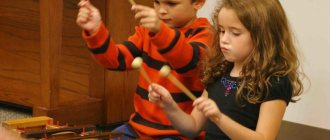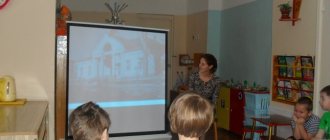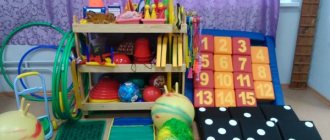How to write a methodological developmentmethodological development on the topic
Memo “How to write a methodological development.”
Methodological development is a manual that reveals the forms, means, methods of teaching, elements of modern pedagogical technologies, or the technologies of teaching and upbringing themselves in relation to a specific lesson topic, curriculum topic, and course teaching in general.
Methodological development can be both individual and collective work. It is aimed at professional and pedagogical improvement of the teacher.
There are quite serious requirements for methodological development.
1. Topic.
2. Full name teacher
3. Purpose of development
4. Abstract. The annotation (3-4 sentences) briefly indicates what problem the methodological development is devoted to, what issues it reveals, and to whom it may be useful.
5. Contents. (describe the parts of the lesson. 1. Involving children in activities. 2. stages of the lesson)
6. Introduction. The introduction (3-4 sentences) reveals the relevance of this work, i.e. the author answers the question why he chose this topic and what is its place in the content of education.
7. The main part is the lesson notes itself.
- Group, type of lesson, educational area, goal, objectives for educational areas or integration of educational areas, preliminary work, material required for the lesson.
- structure (scenario) of the lesson indicating the sequence of its stages and the approximate distribution of time over these stages;
- methods and techniques of the teacher at each stage of the lesson; it is necessary to reflect the goals and objectives of the activities of the teacher and children, methods and means of achieving the goals, the main substantive content of the relevant stages, the organization of work at each stage;
- content of educational material (fragments of the teacher’s speech or the full text of new material);
- tasks for children at each stage, algorithms for completing tasks.
- methodological advice for the immediate aftereffect period (how to sum up, what to do to consolidate the result, etc.).
8. Conclusion. In conclusion (3-4 sentences), the results are summed up on the problematic issues that were posed by the teacher when starting to compile the methodological development.
9. List of sources used.
10. Applications (specific materials that a teacher can use in his work: task cards, diagram cards, visual, didactic material)
11. The volume of the main content is at least half of the entire manuscript.
Composition and content of methodological development
Subject
Usually the topic is built on the principle: subject of research - object of research. The order of the parts of the title may vary.
The object indicates the area to which your development belongs, and the subject indicates what aspects, features you are going to change, the distinctive features of your technique. In other words, an object is the closest supersystem in which you work, and an object is that subsystem or feature that your work changes and improves.
Sometimes the wording itself indicates the GOAL - why this object needs to be improved.
Examples:
Using the Point of View (SUBJECT) model as a tool
integration of speech development and natural history courses (OBJECT)
to form a systemic perception and emotional attitude towards the world around us (GOAL).
The integration of natural history and speech development courses has been done before you, in this case this is the area in which you want to say your new word (object). But using the point of view model as a means to integrate these courses is something new that you have developed (subject).
The subject may have varying degrees of novelty, formulations such as “problems of using the technique...”, “features of using the technique... in the conditions...” are possible. In this case, the methodology itself will be the object (if it already existed before you), and the problems of its application, the features of its use in some new conditions will be the subject of research.
You may not be able to accurately formulate the topic right away. This is normal: if you are solving a pedagogical problem, you are not required to immediately know by what means it will be possible to solve it. Therefore, the goal and object are important at the input, and the object can become clearer later. Recommendations for formulating goals are given below.
Author information
Author of the methodological development (last name – first name – patronymic, place of work and position, contact information: preferably – email address, yours or the school’s address).
Example: Ivanova, Anna Petrovna, primary school teacher at school No. 1, N, teacher of the 1st category, [email protected]
Conditions of use
In this section please indicate
— Student population, characteristics of the population (if any).
— The program within which your methodology is applied.
— If your development is based on the author’s methodology, indicate the name of the basic methodology and its authors.
Example:
— Primary grades (1-2).
— Speech development course as part of the Russian language course
— Methodology for compiling a descriptive story from a picture (Murashkovska I.N., Valums N.P.).
Relevance, purpose and objectives
A well-formulated goal largely determines the success of the entire work. You should not formulate goals in “general terms”: to develop thinking and imagination - the fact of achieving such a goal cannot be verified. Let us indicate the requirements for the formulation of goals and objectives:
1. The goal must be formulated very specifically, so that it can be divided into understandable tasks, the results of which can be verified. 2. The goal must be considered in the general system of goals, i.e. Not only the goal should be clear, but the subgoals (tasks) with the help of which it will be achieved and the supergoals to achieve which your goal is needed. 3. Objectives indicate the changes that should happen to the student and manifest themselves in his behavior or in the results of his work (for example, in the texts he writes) as a result of applying your methodology. They are described by perfective verbs: teach how to write riddles like...; teach to distinguish between the name and meaning of a sign; teach how to use the system operator to write questions about a historical event, etc. We advise teachers who are familiar with OTSM-TRIZ to describe changes using the “element – feature names – feature values” model.
Below are several steps that are useful to take in order to formulate high-quality goals and objectives. This fragment of text (in italics) does not need to be included in the methodological development; it is needed in the process of working on the material.
To correctly formulate your goals and objectives, try doing the following:
1. Answer the question: “what are you going to change with your development?” Describe the expected result: WAS... – IS... And then remove those changes that you did not achieve or achieved using another technique, leave only those that directly relate to your work.
Example: WAS: children give an oral answer about a natural object, haphazardly, using cliches, talk without pleasure, speak with difficulty. – BECOME: children compose a coherent, emotional, imaginative story, examine objects from different angles, use their own comparisons, and tell stories with enthusiasm.
2. Make a chain of “WHY?”, this will help you see the supersystem of goals.
Example. Children know how to compose a coherent, complete story - Why? – To perceive the world around us holistically and systematically. - For what? – To be conscious of the world around you. - For what? – To be able to change the world around us.
Children compose a figurative story using their own comparisons - Why? – To build your own emotional relationship to the world around you. - For what? – To better understand yourself and the world around you.
3. Make a chain “FOR THIS?”, this will help you see the subsystems of goals.
Children compose a figurative story - for this they highlight the most striking fragments of the whole; build metaphors...
By completing this exercise, you will be able to obtain material for three points of methodological development (see below).
1. We get the rationale for the relevance of your work from the chain “WHY?” see paragraph 2 (example: “It is important to teach a child to navigate in the modern dynamic world, to form his own emotional attitude to what surrounds him. The development of figurative speech and associative thinking is one of the main tools for developing an emotional attitude to the world. No less important is the formation holistic, systemic perception of the surrounding world, necessary for a person to detect and solve the problems that arise before him. Together, systemic and figurative descriptions allow one to emotionally experience and appropriate methods of systemic perception of the world"). 2. The purpose of the work is to compare the initial situation (Was) with expectations (BECAME), see point 1 (example: “Teach the construction of a figurative story about an object based on the use of the “Point of View” model”). 3. Tasks - from the chain “WHAT?” see point 3 (example: “Teach to identify the signs of objects on behalf of which the story is built; teach to highlight the signs of surrounding objects that are important from the point of view of the narrator; teach to build figurative comparisons on behalf of the narrator; teach to build systemic comparisons on behalf of the narrator, combining images with unified system").
Facilities
Models, tools, methods
Indicate the models, tools, methods that are used in your development.
Example: The following models are used: “Element – feature name – feature value”, “Point of view”, morphological analysis.
Visual aids
Describe the visual aids you use. If well-known manuals described earlier are used, list them and provide links to the materials in which they are described.
Example: the manual “Circles of Lull” is used (link).
Description of the technique
The description of the methodology can be performed in various forms - it depends on its content.
The main problem of the description is that most of the methods we use are not implemented within one or several lessons, but require a more flexible training system. There is often a situation when the transition to a new stage provides a series of exercises from the previous stage, which can be carried out in any sequence. In this case, it is convenient to present the stages in the form of a diagram (Fig. 1). If your methodological development fits into a clear sequence of steps, there is no need for a diagram.
|
|
The example (Fig. 2) shows a fragment of the description of the methodology, which shows how individual exercises are connected to each other. The “compare an object on behalf of some wizard” exercise may be offered in different sequences, but they precede the system comparison. Empathy can be introduced in parallel with the “What is it like?” exercise. “Systemic empathy” must be preceded by empathy and systemic comparison.
For readers who are not familiar with OTSM-TRIZ pedagogy, we will explain the content of Figure 2. In the methods of developing speech and imagination, images of wizards are used, personifying the methods of transforming objects (Murashkovska I.N., Sidorchuk T.A.). Deli-Come divides objects into parts and combines the parts into a whole; Giant-Little One reduces or increases the size of objects, Lag-Run-Run moves objects along the time line.
If you have presented such a diagram, your next task is to describe each exercise in more detail. This can be done, for example, in the form of a table.
Table 1. Composition of the method
| Task, exercise, procedure | What does a teacher do | What are the children doing | Time, order of work | Recommendations, settings | What happens as a result |
| Compare an object with any other objects | Offers objects, asks questions | Answer questions | 3-5 minutes at the beginning of the lesson. The training is carried out until the result is achieved | First, choose objects that children know and have interesting shapes. Set up children for original answers: (“Vasya compared a boot with a pipe, Masha - with a canal. And the wizard D-D grouped the answers of Vasya and Masha (how?). Who will give an answer that D-D would be difficult to combine with the previous ones?” ) | Children find many comparisons and strive to find an original, unconventional comparison. |
Examples
Often in methodological developments, examples occupy the lion's share of the reader's space and attention. This sometimes leads to completely different results than the author expected. We have encountered cases where a teacher, having read the methodological material, is sincerely convinced that this material can only be used with the examples described in it. To use the “Picture without Stuttering” he needs the same picture with ducks, and the exercise “what does it look like?” must be done exclusively with a class key and glasses. The methodological development should be written in such a way that your colleagues do not copy it one-to-one, but can adapt it to the conditions of their educational process without violating the technology you propose.
Examples illustrate and make your proposals clearer and more specific. But in no case do they replace them.
Example. Let's play the game "What does it look like?" At the initial stage, use objects familiar to children with an interesting shape (for example, a key, glasses, a tree branch, an umbrella, etc.). Then move on to objects with other bright signs (a faucet with dripping water - sound, a burning light bulb - temperature, etc.).
Diagnostics
Diagnostics is a topic that requires separate discussion. As a rule, teachers’ methodological developments do not provide diagnostics; instead, they give examples of children’s works or statements. This enlivens the description of the technique, makes it more readable, but does not make it possible to evaluate the result. So, in lessons on speech development you can always expect 1-2 bright works, but this says absolutely nothing about the value of the methodology used in the lesson. Talented children write brightly and without special training, sometimes the teacher’s intervention only spoils the matter.
If the result of your methodological development can be represented by the creative products of students, it is necessary to show the work of at least 2/3 of the students in the class. This does not mean that you should waste time retyping children's essays or problems created by children. It is enough to attach photocopies of them to the description of the methodology. When publishing your design, we will decide how to illustrate it with children's work.
Another option is to use previously developed diagnostics. In this case, it is necessary to cite sources.
If you decide to offer your own diagnostics of the results of using your technique (for which you immediately deserve special thanks), then you need to answer two questions:
1. By what objects did you evaluate the results of your work? It can be
- observed behavior of children (children ask to conduct such lessons more often, bring additional material, play games suggested by the teacher during recess - such observations indicate an increase in motivation);
- products of children’s creative activity (essays, rules derived by children, tasks invented by them, etc.);
— results of performing special tasks, etc.
2. What characteristics will you evaluate?
It can be
- the presence of certain statements by students in the process of work,
- certain types of behavior of students (for example, if a child collects a piggy bank, practically without asking for help from the teacher and classmates and gets a result, one can judge independence in this type of activity); if a student uses systematic comparisons in the text, one can judge the maturity of the ability to make such comparisons);
— the number of correct answers to the proposed tasks; number of errors of a certain type, etc.
If you evaluate work in points, under no circumstances consider the arithmetic average as the result for the class. Two students who caught the flu that day, did not complete the work and received unities, will negate the results of at least four excellent students. Just count the number of twos, threes, fours, fives, etc. and the percentage of the number of this grade to the number of students who did the work. If the work is assessed, for example, on a ten-point scale, you can count the number of students whose results fall within certain intervals (for example, 0-5; 6-10; 11-20, etc.). The results can be reflected in a diagram.
conclusions
Briefly review what your work was about. What problems have you not yet been able to solve? Set yourself goals for the future.
Please do not forget that today many teachers in different parts of the country are waiting for your materials.
Bibliography and links
This list should contain all the materials that you used when creating your own methodological development.
— Materials published in the press (articles, books, textbooks, etc.);
- Materials posted on Internet sites (in this case, the address of the material on the network is given, for example, Murashkovska I.N., Valyums N.P. Picture without hesitation. [WWW document] URL https://trizminsk.org/e/ 2312.htm)
- Materials placed on CDs (example description: Nesterenko A.A., Belova G.V. Knowledge workshop: tools for problem-based learning based on OTSM-TRIZ // Effective educational technologies [Electronic resource]. - Electronic text , graphics, sound, video data (57.2 MB) - M.: LLC "Distance Technologies and Education", 2008. - Issue 1. - 1 electronic optical disk (CD-ROM) : sound ., color; 12 cm – 9.72 Mb.)
In the text of the article, references can be made to the publication numbers in the list, preferably indicating pages [1, pp. 34-35], or you can use the European system (full name of the author, year when the material was published), for example (Ivanov I.I. , 2007, p. 34).
If you are using ideas from colleagues that were communicated in a private conversation, instead of a link in brackets you can write (Ivanov I.I., private message)







